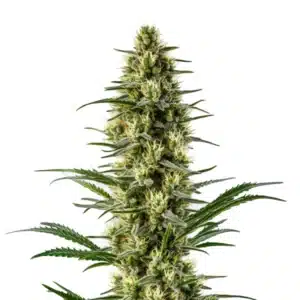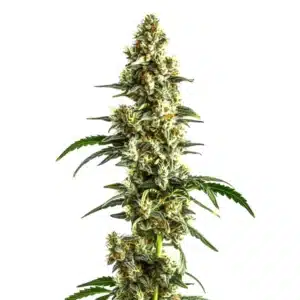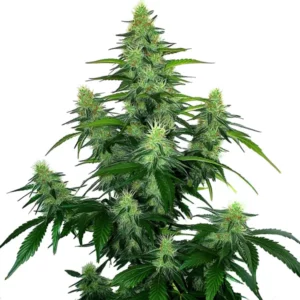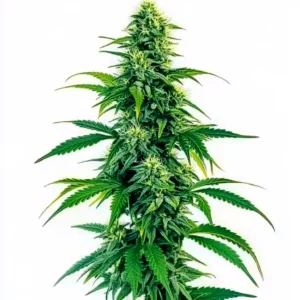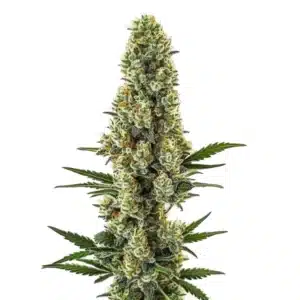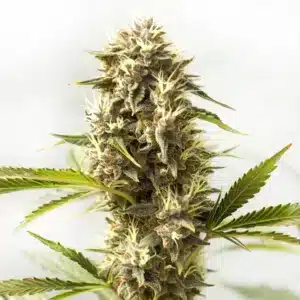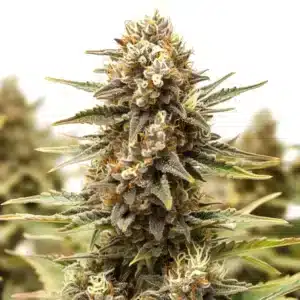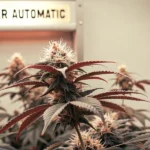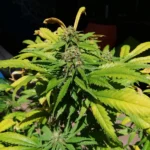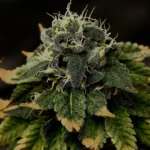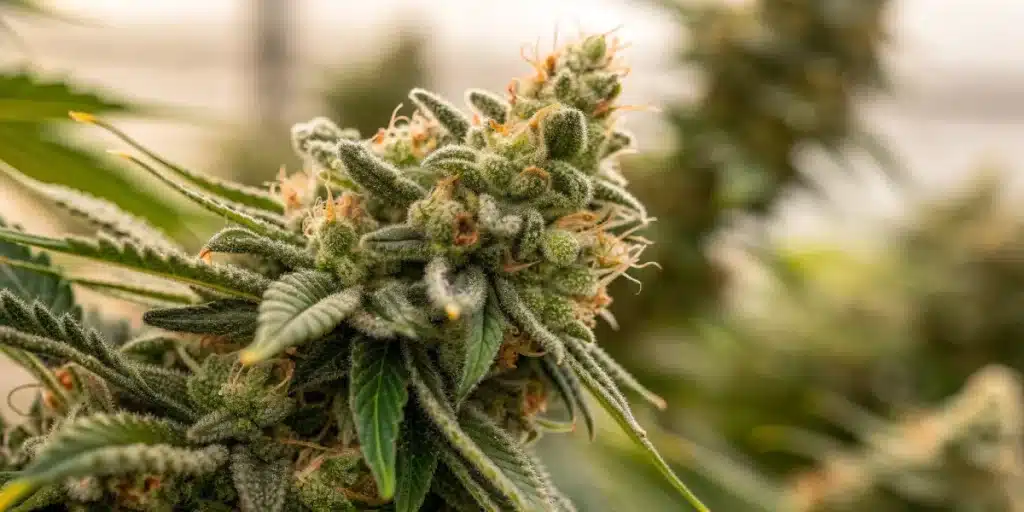
How to Grow Agent Orange Weed Strain
Agent Orange Weed Strain Description
Agent Orange combines Orange Velvet and Jack The Ripper (F2) to create a mostly Sativa hybrid (75% Sativa / 25% Indica). It offers medium THC levels of 21%–22% and low CBD at 0.5%, delivering a happy, energetic experience with light relaxation. The resinous buds give off a fruity aroma and display bright orange hairs against deep green calyxes.
Users report euphoric, happy, and relaxed effects, making it a favorite for daytime use. Its terpene profile rich in Myrcene, Limonene, Pinene, Caryophyllene, and Linalool supports relief from depression (Caryophyllene & Linalool), insomnia (Myrcene & Terpineol), and muscle spasms (Myrcene & Humulene). Plants stay compact at about 4.92 ft (1.5 m) and finish in 8–10 weeks, producing low yields of 1.64–1.97 oz/ft² (500–600 g/m²) indoors or 3–10 oz/plant (90–300 g) outdoors.
Recommended Strains
Agent Orange
|
|
THC | 21% - 22% (Medium) |
|
|
Type | Feminized |
|
|
Yield | High |
|
|
Phenotype | 25% Indica / 75% Sativa |
Agent Orange Regular
|
|
THC | 16% - 19% (Medium) |
|
|
Type | Regular |
|
|
Yield | High |
|
|
Phenotype | 30% Indica / 70% Sativa |
Promos & Deals
Growing Environment
Agent Orange thrives in a warm, sunny climate. Indoors, maintain temperatures between 70°F and 80°F (21°C–27°C) with nights a few degrees cooler to enhance resin production. Keep humidity at 60%–70% during vegetative growth, then reduce to 40%–50% in flowering to prevent mold and boost terpene concentration.
Outdoors, choose a spot that receives at least six hours of direct sunlight daily. Enrich soil with organic compost or worm castings before planting. Protect plants from strong winds with fences or hedges and ensure good airflow through proper spacing to reduce pest and mildew risks.
Setting Up Your Grow Space
Agent Orange Weed Strain Indoor Cultivation
Set up a grow tent or dedicated room with reflective Mylar walls to maximize light. Use full-spectrum LED or HPS lamps on an 18–20 hour cycle during vegetative growth. Install an exhaust fan and carbon filter to control temperature, humidity, and odor.
Start seedlings in small pots (1–2 gallons) filled with a light, well-draining mix. Maintain soil pH at 6.0–6.5. Transplant into final containers early to avoid transplant shock and ensure steady growth throughout the 8–10 week cycle.
Agent Orange Weed Strain Outdoor Cultivation
Plant Agent Orange after the last frost in nutrient-rich, well-draining soil. Use raised beds or large pots for better root aeration. Space plants at least 3 feet apart to ensure proper airflow and sunlight penetration.
Water deeply but infrequently, allowing the top inch of soil to dry between sessions. Mulch around the base to retain moisture and suppress weeds. In rainy climates, provide a simple canopy to avoid bud rot during flowering.
Seed Propagation and Germination
Soak seeds in distilled water or a light hydrogen peroxide solution (1:10) for 12–24 hours. Transfer to moist paper towels at 75°F–80°F (24°C–27°C) until taproots appear, then plant taproot-down about ½ inch into soil. Cover lightly and keep humidity high under a dome or plastic wrap.
Once seedlings emerge, provide 18–20 hours of gentle light. Remove the humidity cover gradually over three days. Avoid overwatering by misting the surface and letting excess moisture drain away to prevent damping off.
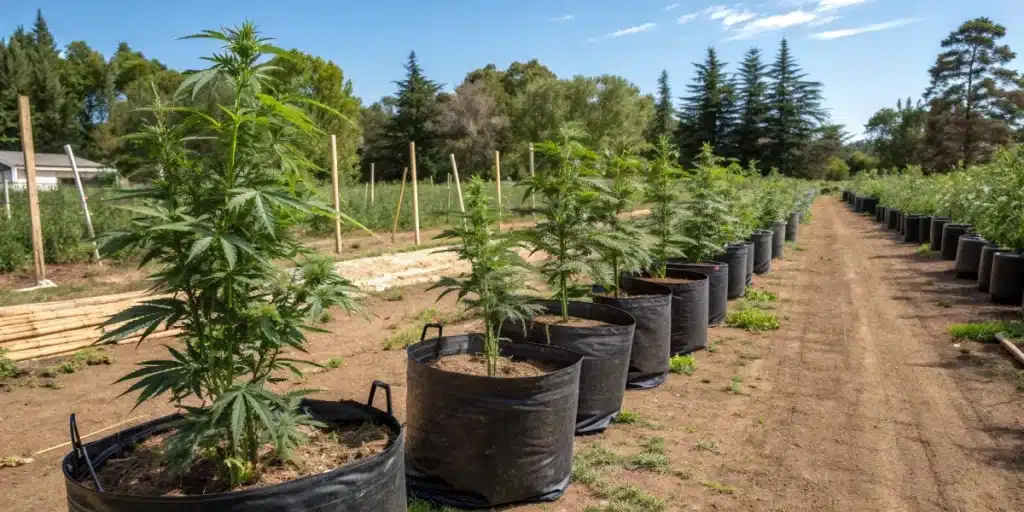
Agent Orange Weed Strain Vegetative Phase
Maintain an 18–20 hour light schedule with LEDs or CFLs positioned 18–24″ above the canopy. Begin feeding a nitrogen-rich nutrient solution (N-P-K around 3-1-2) at half strength every 7–10 days. Train plants with low-stress techniques (LST) during weeks 2–3 to develop an even canopy.
Keep temperatures between 70°F and 80°F and humidity at 60%–70%. Water when the top inch of soil dries, and monitor EC and pH daily. Introducing beneficial microbes, such as a Mycorrhizae inoculant, can boost root health and nutrient uptake.
Agent Orange Weed Strain Flowering Phase
Switch to a 12/12 light cycle to trigger flowering, even though Agent Orange is photoperiod-sensitive. Feed a bloom nutrient mix rich in phosphorus and potassium (N-P-K around 1-3-2) once flowering begins. Lower humidity to 40%–50% to prevent mold and to concentrate terpenes.
Remove large fan leaves that shade bud sites (“lollipopping”) around week 4 to improve airflow and light penetration. Support heavy colas with stakes or a trellis when buds swell in weeks 6–8. Monitor trichomes weekly; harvest when 70–80% turn cloudy for peak THC content.
Fertilization and Nutrition
Start with a balanced vegetative formula (3-1-2) until week 3, then switch to a bloom formula (1-3-2) from week 4 to 7. Add calcium-magnesium supplements if leaves show signs of deficiency. Always flush with plain water during the final week to remove nutrient buildup and improve flavor.
Consider organic amendments like kelp meal or bat guano in soil to enhance microbial diversity. Foliar feeding with a light nutrient spray in early flowering can boost flower development without altering root-zone pH.
Pest and Disease Control
Inspect plants daily for spider mites, aphids, and whiteflies. Use yellow sticky traps to monitor populations. Apply neem oil or insecticidal soap at first sight of pests, ensuring to cover undersides of leaves.
Prevent powdery mildew and bud rot by maintaining good airflow and keeping humidity below 50% in flowering. Remove and destroy any infected foliage immediately, and avoid overhead watering during bloom.
Agent Orange Weed Strain Harvesting and Curing
Harvest when 70–80% of trichomes are cloudy and a few amber. Cut branches and trim large leaves. Hang upside-down in a dark, ventilated room at 60°F–70°F and 50% humidity. Rotate branches every 2–3 days for even drying.
After 7–10 days, when stems snap, remove buds and place in glass jars filled to ¾ capacity. “Burp” jars daily for the first week, then weekly for 2–4 weeks. Maintain jar humidity at 60%–62% with small humidity packs to refine flavor and smoothness.
Is Agent Orange Indica or Sativa?
Agent Orange is mostly Sativa (75% Sativa / 25% Indica). It delivers a bright, uplifting high that sharpens focus and energy, followed by a gentle body relaxation ideal for daytime adventures and creative tasks.
Advantages and Disadvantages
Advantages: Fast 8–10 week cycle, vibrant citrus aroma, clear energetic high, helpful against depression and insomnia, compact size for discreet grows. Its strong Sativa drive boosts mood and creativity.
Disadvantages: Low yield compared to heavy-producing strains, photoperiod needs a light schedule change, minimal body sedation may not suit evening use, requires precise humidity control to avoid mold.
Why Buy Agent Orange Weed Strain
Choose Agent Orange for its distinct fruity aroma, energetic Sativa effects, and reliable 8–10 week harvest. Feminized seeds guarantee female plants and simplify grow planning. Beginners benefit from its forgiving genetics and moderate growth habits.
Its medical potential for depression, insomnia, and muscle spasms makes it a versatile choice. Trusted seed banks offer stable genetics to ensure consistent results in both indoor and outdoor settings.
Problems in Cultivation Agent Orange Weed Strain
Overwatering can lead to root rot use well-draining soil and allow the top layer to dry between waterings. Nutrient burn may occur if feeding is too strong; start at half strength and adjust upward. Sudden humidity spikes in flowering can trigger mold; monitor and adjust dehumidifiers as needed.
Stretch during early flowering can cause uneven canopies. Use LST or a SCROG net to control height and ensure even light distribution. Late-season nutrient deficiencies can impact bud quality; maintain consistent feeding and pH monitoring throughout the cycle.

Similar Strains
Orange Bud
Orange Bud is a 70% Sativa hybrid famed for its sweet citrus aroma and uplifting high. It flowers in 8–9 weeks and yields moderate harvests of dense, orange-tipped buds, making it a natural companion to Agent Orange.
Jack Herer
Jack Herer blends Haze, Northern Lights, and Shiva Skunk genetics into a 55% Sativa hybrid. It offers a spicy-pine aroma and clear, creative energy. It finishes in 8–10 weeks with moderate yields.
Tips for Professionals
Use digital controllers to automate temperature and humidity. Employ SCROG or SOG techniques to maximize canopy efficiency in limited spaces. Integrate beneficial microbes like Trichoderma to enhance root health and nutrient uptake.
Experiment with extended flush cycles or slight late bloom PK boosts to enhance terpene profiles. Record each grow’s data light intensity, nutrient schedule, and environmental conditions to refine your next harvest for higher potency and yield.
FAQs
What makes Agent Orange unique?
Agent Orange stands out for its intense citrus aroma and predominantly Sativa effects that combine energy with mild relaxation. Its medium THC (21%–22%) and low CBD make it ideal for daytime use, boosting creativity and mood without heavy sedation.
How long does flowering take?
Agent Orange flowers in 8–10 weeks under optimal conditions. Maintaining a consistent 12/12 light cycle, stable humidity (40%–50%), and proper nutrient schedule speeds up bud development and enhances resin production.
Can beginners grow it successfully?
Yes Agent Orange’s forgiving genetics handle minor environmental fluctuations well. Beginners should monitor pH and humidity closely, use half-strength nutrients initially, and employ simple LST to manage height and canopy density for even light distribution.


